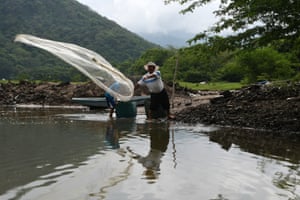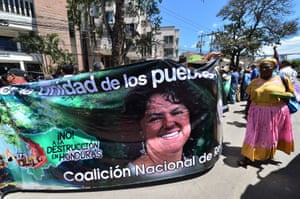It won’t be long’: why a Honduran community will soon be under water
by Nina Lakhani in Cedeño, Choluteca From The Guardian UK

Rising sea levels are destroying coastal towns in Honduras – and shrimp farms which export to the UK and US are making it worse
Eric Pineda runs a modest beachfront restaurant which serves up plates of fresh fish and rice – and faces imminent destruction.
A recent tidal surge razed the nightclub next door, leaving a pastel pink ruin, and in the past two years, several other businesses between Pineda’s property and the Pacific Ocean have been destroyed by sudden waves.
“Every year, the ocean is getting closer and higher. I think we’ve got a year – maybe two – before the water takes us too,” said Pineda, 24. “It won’t be long.”
Golden beaches once helped transform this fishing community on the Gulf of Fonseca into a thriving tourist destination. Nowadays, however, there are barely a few metres of sand left, and rising water levels and tidal surges have wiped out roads, homes and businesses. Locals estimate that around a metre of ground is lost every year – which means this entire community will soon be under water. The same predicament is faced by settlements along the Pacific coast of Honduras, where land and its people are disappearing fast.


In recent years, millions of people have fled Central America to escape grinding poverty, institutional collapse and untrammeled violence. But another factor behind the exodus has received less attention: conflicts over natural resources which have been intensified by corporate expansion and climate change.
Sea levels are rising around the world, but in this region another local factor is helping speed up coastal degradation: swathes of mangrove forests have been destroyed to make way for industrial shrimp farms which have proliferated even inside protected reserves.Advertisement
Many Honduran shrimps are exported to the US and the UK, where they are sold in major supermarket chains including Waitrose, Sainsbury’s and Marks & Spencer.
“The industry destroys huge mangrove sites promising development, but actually creates very few jobs – and actually increases poverty by restricting fishing access for locals,” said Dina Morel, director ofa local marine conservation organization, known by its acronym Coddeffagolf.
According to Morel, shrimp farms are routinely approved in protected areas and environmental violations rarely punished as officials often have vested interests in the profitable industry.
“The consequences of losing this essential ecosystem are clear,” said biologist Víctor Bocanegra. “Environmental vulnerability, food insecurity, poverty and social decomposition, which all leads to forced migration.”
Mangroves are essential to healthy, resilient coastlines. The sturdy trees protect shorelines from storms and floods, and help prevent erosion by stabilizing sediments with their intertwined roots.


They are key factors in marine biodiversity, providing food, clean water, shelter and safety for fish and invertebrates such as crabs, lobsters and prawns.Advertisement
In order to take advantage of this natural symbiosis, acres and acres of shrimp farms have been built inland in ocean inlets which were once safe havens for tidal waves. But the farms block the natural flow of water, causing high tides and storm surges to immerse beach communities instead.
On Cedeño beach, Ariana Tees, 70, is frying fish caught by her husband, Manuel, 67, in a makeshift tarpaulin kitchen just metres from the sea. This is where they live, work, eat and sleep, but every month they are forced further and further back as the ocean inches closer inland.
Every year, the ocean is getting closer and higher. I think we’ve got a year – maybe two – before the water takes us tooEric Pineda
“Of course we’re scared,” said Tees. “But we’ve nowhere else to go, and there’s no protection from the government, not even a barrier.”
Manuel, who has been fishing since he was a child, said: “Every year there is less fish, and the surges have nowhere to go – so the water comes here looking for an exit. We’ve woken up in the middle of the night surrounded by water.”
He paused, before concluding: “Basically we’re fucked.”
The shrimp industry in southern Honduras dates back to the 1970s, but grew exponentially in the 1990s. As a result, in 2000, seven mangrove forests covering over 150,000 acres were designated protected reserves.


Despite this, half the region’s mangroves were destroyed between 2000 and 2010 – largely as a result of fishing concessions sanctioned before the decree, according to research by Coddeffagolf.
No one knows exactly how much of the protected areas remain intact, but satellite images seen by the Guardian suggest the situation is critical.
The extent of the deforestation can be seen from a mountain peak in San José de Las Conchas, 20 miles north of Cedeño, where the panorama reveals only slivers of protected mangroves nestled between massive manmade shrimp lagoons and the turquoise ocean.
We’ve woken up in the middle of the night surrounded by water.Manuel Tees
Locals say shrimp companies build farms in secret – hidden from view by a ring of mangroves – then obtain permits retrospectively.
Sales figures suggest shrimp farms are expanding: $216m of shrimps were exported last year, a figure expected to rise by up to 20% in 2019.
FundeSur, a social responsibility foundation created by the shrimp industry in 2014, claims to invest $0.02 for every pound of shrimp exported into health, education and environmental projects.
But reforestation programmes, which require years of nurturing to ensure hardy shrubs, are rare. FundeSur did not respond to repeated requests for comment.
“There is more deforestation than reforestation, that’s evident for everyone to see,” said Nelson Martínez, a grassroots organiser from Guapinol, a nearby community badly damaged by a tidal surge three years ago. “Unless the mangroves are saved, Guapinol will disappear too.”
A thin strip of land sandwiched between the Pacific and Atlantic oceans, Central America is especially vulnerable to the global climate emergency.


Between 1998 and 2017, Honduras was the second country or territory most affected by extreme weather events such as floods, storms, droughts and wildfires, according to the Global Risk Index. (Puerto Rico came first.)
Hurricane Mitch – the most deadly storm in the western hemisphere in over two centuries – left at least 8,000 people dead and a million others homeless and landless when it struck in 1998. It set the country’s economic development back at least 50 years and triggered the first wave of post-cold war Central American migration to the US.
Yet, investment in climate mitigation and adaption programmes such as reforestation and flood defences is falling.
Only 0.5% of the central government budget is allocated to environmental protection this year, down from 1.2% in 2010, according to analysis by economist Hugo Pino, a former finance minister and central bank governor.
Since a 2009 coup, a profusion of water-guzzling megaprojects – including dams, mines, and African palm plantations – has fuelled social conflicts, state repression and migration.
Berta Cáceres, a Goldman environmental prize winner, was murdered in March 2016 in retaliation for leading opposition to the construction of a hydroelectric dam on the river Gualcarque, relied upon by the indigenous Lenca people for food, water and medicines.


“The key issue connecting climate change and governments is water governance – the politics deciding who gets priority to enough good quality water,” said Professor Raúl Pacheco-Vega, an environmental politics scholar at the centre for economic research and teaching (Cide) in Mexico.
In Honduras, the upshot of water politics is stark: every year during the rainy season, countless communities are cut off, lives are lost, and roads, bridges and schools are damaged. It is a cycle of environmental destruction that exacerbates poverty and drives migration as families search for food, water and safety.
In October, six people were killed after two days of torrential rain triggered landslides and the River Choluteca burst its banks. The town of Marcovia, 14 miles inland from Cedeño, was inundated and its habitants forced to leave.
Soon after, hundreds of people from the nearby city of Choluteca joined a caravan of migrants heading north through Mexico to the US border.
Half a million Hondurans heading north have been apprehended by US and Mexican officials since October 2016.
The motives for migration are always complex, but in this region, environmental factors are increasingly important.
Pedro Landa from Eric, a Jesuits human rights research organisation, said the lessons from Mitch were never learned. “Since the [2009] coup, the state has been increasingly controlled by mafia politicians with no interest in guaranteeing water supplies or economic development for ordinary people, just for themselves.”
As the crisis escalates…
… in our natural world, we refuse to turn away from the climate catastrophe and species extinction. For The Guardian, reporting on the environment is a priority. We give reporting on climate, nature and pollution the prominence it deserves, stories which often go unreported by others in the media. At this pivotal time for our species and our planet, we are determined to inform readers about threats, consequences and solutions based on scientific facts, not political prejudice or business interests.
More people are reading and supporting The Guardian’s independent, investigative journalism than ever before. And unlike many news organisations, we have chosen an approach that allows us to keep our journalism accessible to all, regardless of where they live or what they can afford. But we need your ongoing support to keep working as we do.
The Guardian will engage with the most critical issues of our time – from the escalating climate catastrophe to widespread inequality to the influence of big tech on our lives. At a time when factual information is a necessity, we believe that each of us, around the world, deserves access to accurate reporting with integrity at its heart.
Our editorial independence means we set our own agenda and voice our own opinions. Guardian journalism is free from commercial and political bias and not influenced by billionaire owners or shareholders. This means we can give a voice to those less heard, explore where others turn away, and rigorously challenge those in power.
We need your support to keep delivering quality journalism, to maintain our openness and to protect our precious independence. Every reader contribution, big or small, is so valuable. Support The Guardian from as little as $1 – and it only takes a minute. Thank you.
For more on this story and to donate go to; https://www.theguardian.com/global-development/2019/jul/31/honduras-community-coastal-towns-rising-sea-le




